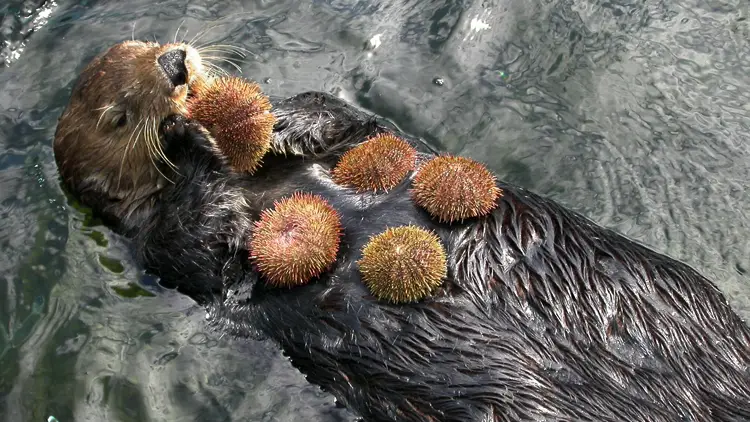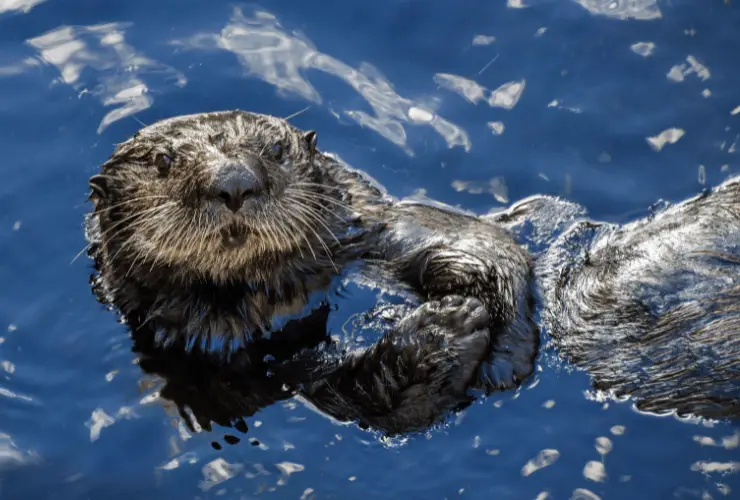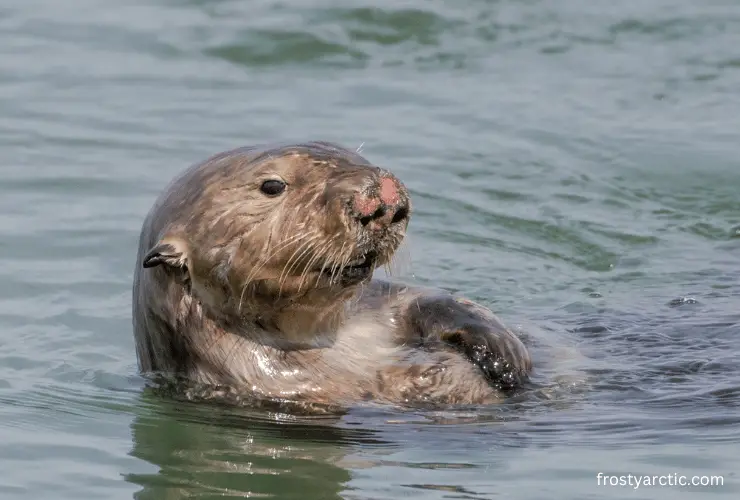Yes, sea otters do eat sea urchins. Sea urchins are, in fact, a significant part of the sea otter’s diet, providing essential nutrients. Red and purple sea urchins are their favorites. But they can consume other sea urchin species when they are available.
They use their skill to get past the sea urchin’s spiky exterior, effectively managing to feast on the creature inside.
Ever wondered, “Do Sea otters eat sea urchins?” Well, you are in for an intriguing discovery! Sea otters are surprisingly adept hunters, fond of dining on sea urchins.
They spend much time searching for food from dawn to dusk, with sea urchins being their go-to choice. This eating habit does more than just fill their bellies — it plays a big role in keeping the ocean environment healthy. But how do sea otters get around the spines of sea urchins when they eat them?
Let’s take a deep dive into the world of sea otters. We will shed light on their dietary habits and remarkable ability to navigate the challenging task of feasting on sea urchins.
Do Sea Otters Eat Sea Urchins? What Type of Sea Urchins Do Sea Otters Eat?

Sea otters have a diverse diet. Their menu includes nearly 100 different types of creatures, but sea urchins hold a special place in their diet. Despite their spiny exterior, sea otters just love them! ~ Source
But which types of sea urchins do they enjoy?
Sea otters’ diet preferences can vary based on location, prey availability, and the individual sea otter’s learned behaviors. Let’s find out what types of sea urchins they enjoy feasting on.
Red Sea Urchins (Strongylocentrotus franciscanus)
These bright red urchins are a hit with sea otters. They make a satisfying meal with a size that can reach up to 7 inches in diameter. They are abundant in rocky places and kelp forests—areas sea otters often explore for food. ~ Source
Purple Sea Urchins (Strongylocentrotus purpuratus)
Purple sea urchins may be smaller than their red relatives, but they are a nutritional powerhouse that sea otters adore. They reside in different habitats, from rocky shores to kelp forests and even under the sand — making hunting them an exciting game for sea otters. ~ Source
Green Sea Urchins (Strongylocentrotus droebachiensis)
The green sea urchin occasionally makes its way into a sea otter’s diet, especially those living in the northern Pacific regions. They prefer the chill of deeper, colder waters and stand out with their bright green, spiky shells.
Giant Sea Urchins (Mesocentrotus giganteus)
Giant sea urchins inhabit the rocky undersea areas of the Pacific, from Japan to Baja California. Their large size and nutrient-rich content make them a tempting treat for sea otters.
White Sea Urchins (Lytechinus anamesus)
Although not as common, the White Sea Urchin has also been observed in the sea otter’s diet. They live in both sandy and rocky marine habitats and are known for their pale or white coloration.
So, whether red, purple, green, giant, or white, sea urchins offer sea otters a nutritious and tasty meal, bringing a delightful variety to their underwater dining.
Why Do Sea Otters Eat Sea Urchins?

Sea otters eat sea urchins for various reasons. Let’s dig deeper.
Meeting Nutritional Needs
Sea otters need a high-energy diet to stay active. Sea urchins are densely packed with proteins and other essential nutrients, perfect for a sea otter’s needs. Indeed, just one sea urchin can meet up to 15% of a sea otter’s daily energy needs.
Variety and Availability
Sea urchins are abundant in the marine habitats where sea otters live. They are readily available and relatively easy for sea otters to find and catch, making them a practical food choice.
The Learned Behavior
Sea otters learn to hunt and eat sea urchins from their mothers and other adults in their community. This learned behavior becomes a cultural trait passed from generation to generation.
Controlling the Ecosystem
Sea otters play a crucial role in keeping kelp forests healthy by keeping a check on sea urchin populations. Without sea otters, sea urchins can run wild, munching away on kelp and turning lush underwater forests into barren landscapes. By dining on sea urchins, sea otters help ensure a balanced and thriving ecosystem.
This relationship is a perfect example of the interconnectivity of life in the ocean, demonstrating how one creature’s eating habits can significantly impact its environment.
How Do Sea Otters Eat Sea Urchins?
Eating a sea urchin is no easy task, given its spiky exterior. But sea otters are experts at it. They float on their backs on the water’s surface and place the sea urchin on their chest, which serves as a table.
Holding a rock in one hand and the urchin in the other, they hammer away with precision and patience. Sea otters then feast on the soft and nutritious insides once they’ve broken through the spiky exterior.
Young sea otters learn this complex behavior by observing and imitating adults. It can take a few tries (and perhaps a few pricked paws) before they master the art of cracking open a sea urchin.
After the sea otters finish their meal, the remnants of their feast – urchin shells and spines – drift to the ocean floor. These ‘sea urchin graveyards’ testify to the sea otters’ role in controlling sea urchin populations.
How Many Sea Urchins Do Sea Otters Eat a Day?

Sea otters have a super-fast metabolism, helping them stay warm and energetic in the chilly ocean waters. This means they must eat a lot — about 25% to 30% of their body weight daily! ~Source
In numbers, for a sea otter weighing between 30 and 100 pounds, that’s around 7.5 to 30 pounds of food daily.
So, given their preference for sea urchins, how many spiky creatures does a sea otter consume in a day?
According to 2012 research published in the Journal of Marine Sciences, sea otters living in the central and western Aleutian Islands can easily meet their daily energy needs by foraging in either kelp forests or urchin-barren areas.
A male sea otter weighing about 34 kg needs roughly 4600 calories per day. The number of sea urchins a sea otter would have to eat to meet this energy need varies depending on the area.
In kelp forests, due to the difference in availability, size, and energy, the urchins provide, a sea otter would need to eat about 484 sea urchins. This process takes about 18% of the otter’s time, with a feeding rate of approximately 1.9 urchins per minute.
In urchin barrens, however, a sea otter would need to consume around 1085 urchins, taking up to 25% of their time at a faster rate of 3 urchins per minute.

These percentages are considerably lower than what sea otters in areas with scarce food resources experience. For example, male sea otters in central California spend 25 to 40% of their time feeding.
But only sea urchins are one of the many dishes sea otters enjoy. They also love to feast on a variety of other sea creatures, like crabs, snails, and shellfish. Yet, there’s no denying that sea urchins hold a special place in their hearts — or, should we say, their stomachs?
By munching on sea urchins, sea otters help balance the marine ecosystem, promoting the growth of kelp forests and supporting the diversity of life beneath the waves.
FAQs
Q: Do Sea Otters eat sea stars?
A: Yes, sea otters do eat sea stars, also known as starfish. Sea otters have a diverse diet that includes a variety of invertebrates. Although sea urchins, crabs, and clams are some of their favorites, they will also eat other creatures in their marine habitat, including sea stars.
Wrapping Up
So, do sea otters eat sea urchins? Sea otters love sea urchins, especially red and purple sea urchins. They smartly use rocks to crack open these thorny creatures.
This clever feeding strategy, known as ‘percussive foraging,’ sets sea otters apart, placing them in the small group of mammals known to use tools. Their broad palette of urchins is not only a testament to their dietary adaptability but also plays a key role in controlling urchin numbers and keeping underwater ecosystems healthy.
So, sea otters are not just urchin lovers. They are also key players in maintaining the balance of life beneath the ocean waves. We hope you enjoyed exploring the love of sea otters for sea urchins. Stay tuned for more otter-ly-filled adventures.



3 thoughts on “Do Sea Otters Eat Sea Urchins?”